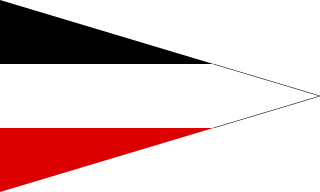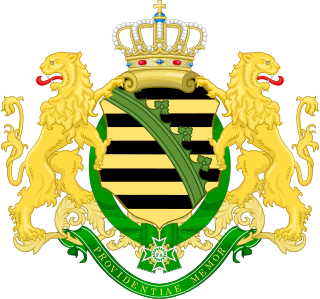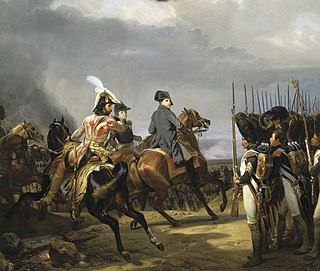Related Research Articles

The Battle of Pułtusk took place on 26 December 1806 during the War of the Fourth Coalition near Pułtusk, Poland. Despite their strong numerical superiority and artillery, the Russians suffered the French attacks, before retiring the next day having suffered greater losses than the French, disorganizing their army for the rest of the year.
This is the complete order of battle of the French and Third Coalition armies during the Battle of Austerlitz.

This is the order of battle for both the Russian and German armies at the Battle of Tannenberg, August 17 to September 2, 1914.
The following units of the German First Army and British Expeditionary Force fought in the Battle of Mons in World War I.

The Guards Cavalry Division (Garde-Kavallerie-Division) was a unit of the Prussian Army that was stationed in Berlin. The division was a part of the Guards Corps (Gardekorps).
The following units and commanders fought in the Battle of Eylau of the Napoleonic Wars.
This is an order of battle of the French and German Armies at the beginning of the Franco-Prussian War in 1870.

The Royal Saxon Army was the military force of the Electorate (1682–1807) and later the Kingdom of Saxony (1807–1918). A regular Saxon army was first established in 1682 and it continued to exist until the abolition of the German monarchies in 1918. With the formation of the Confederation of the Rhine by Napoleon the Royal Saxon Army joined the French "Grande Armée" along with 37 other German states.
The Army of the Danube was a field army of the Russian Empire, created for the Russo-Turkish War of 1806–1812.

On 25 March 1799, French and Habsburg armies fought for control of the geographically strategic Hegau in present-day Baden-Württemberg. The battle has been called by various names: First Battle of Stockach, the Battle by Stockach, and, in French chronicles, the Battle of Liptingen.
The following units of the British, French and German Empires fought in the First Battle of the Marne from 5–12 September 1914 on the Western Front of World War I.
The Hanau order of battle shows the forces engaged at the 1813 battle of Hanau, during the War of the Sixth Coalition, when a French force under Emperor of the French Napoleon I defeated a vastly superior Austro-Bavarian force commanded by General Karl Philipp von Wrede.

The Jena-Auerstedt campaign order of battle is listed below. The order of battle includes units from the First French Empire and the Kingdom of Prussia that fought each other in the campaign that included the decisive Battle of Jena-Auerstedt on 14 October 1806. The order of battle may be useful to trace the battles of Schleiz and Saalfeld, which occurred before Jena-Auerstedt, as well as battles and capitulations that happened after 14 October, such as Erfurt, Halle, Prenzlau, Pasewalk, Stettin, Waren-Nossentin, and Lübeck.

The Battle of Czarnowo on the night of 23–24 December 1806 saw troops of the First French Empire under the eye of Emperor Napoleon I launch an evening assault crossing of the Wkra River against Lieutenant General Alexander Ivanovich Ostermann-Tolstoy's defending Russian Empire forces. The attackers, part of Marshal Louis-Nicolas Davout's III Corps, succeeded in crossing the Wkra at its mouth and pressed eastward to the village of Czarnowo. After an all-night struggle, the Russian commander withdrew his troops to the east, ending this War of the Fourth Coalition action. Czarnowo is located on the north bank of the Narew River 33 kilometres (21 mi) north-northwest of Warsaw, Poland.
The II Cavalry Corps of the Grande Armée was a French military unit that existed during the Napoleonic Wars. It was first formed in December 1806, but only enjoyed a brief existence under Marshal Jean-Baptiste Bessières. The II Cavalry Corps was reconstituted for the invasion of Russia in 1812 and commanded by General Louis-Pierre Montbrun who was killed in battle, as was his successor a few hours later. During the War of the Sixth Coalition, General Horace François Bastien Sébastiani de La Porta led the II Cavalry Corps in 1813, while General Antoine-Louis Decrest de Saint-Germain led the corps in 1814. During the Hundred Days, Emperor Napoleon Bonaparte raised the corps again and entrusted it to General Rémi Joseph Isidore Exelmans.

The 6th Cavalry Division was a unit of the German Army that fought on Eastern and Western Fronts during World War I. The division was formed on the mobilization of the German Army in August 1914 and was disbanded in 1919 during the demobilization of the German Army after World War I.
The history of the German Cavalry in World War I is one of an arm in decline.
The VIII Corps of the Grande Armée was a French military unit that existed during the Napoleonic Wars. Emperor Napoleon I formed it in 1805 by borrowing divisions from other corps and assigned it to Marshal Édouard Mortier. Marshal André Masséna's Army of Italy was also reorganized as the VIII Corps at the end of the 1805 campaign. The corps was reformed for the 1806 campaign under Mortier and spent the rest of the year mopping up Prussian garrisons in western Germany.
The Reserve Cavalry Corps or Cavalry Reserve of the Grande Armée was a French military unit that existed during the Napoleonic Wars. In 1805, Emperor Napoleon Bonaparte appointed Marshal Joachim Murat to command all the cavalry divisions that were not directly attached to the army corps. During the Ulm campaign, Murat led his horsemen in successfully hunting down many Austrian units that escaped the capitulation of Ulm, before fighting at Austerlitz in December 1805. Under Murat, the Cavalry Reserve played a prominent role in the destruction of the Prussian armies after the Battle of Jena-Auerstedt in 1806. In 1812, the Reserve Cavalry Corps was split up into the I, II, III, and IV Cavalry Corps for the French invasion of Russia.
References
- ↑ Michael de Tolly was appointed the commander-in-chief of the 1st Army on 19 March 1812. However, after arrival of Emperor Alexander I in Vilnius, the latter became de jure and de facto a commander-in-chief.
- ↑ In June 1812 the 1st Infantry Corps was excluded from the 1st Army and left by the Northern Dvina for protection of Saint Petersburg
- ↑ Riehn, Richard (1991). 1812: Napoleon's Russian Campaign. United States: John Wiley & Sons. pp. 444–464. ISBN 0-471-54302-0.
- ↑ the correct name for both the town and the regiment is "Kargopol"
- ↑ Podmazo, Alexander (22 April 2003). Русская армия в июне 1812 г. [Russian Army in June 1812] (in Russian). Retrieved 27 June 2018.